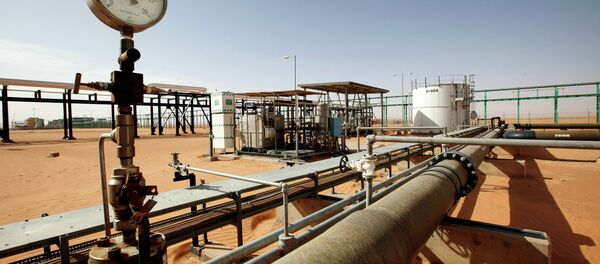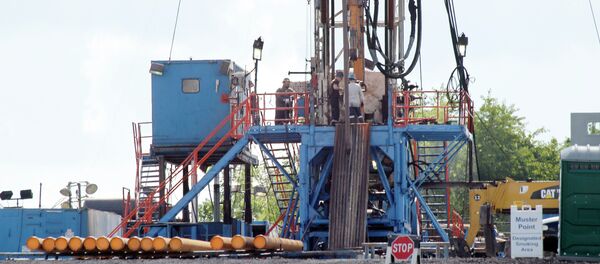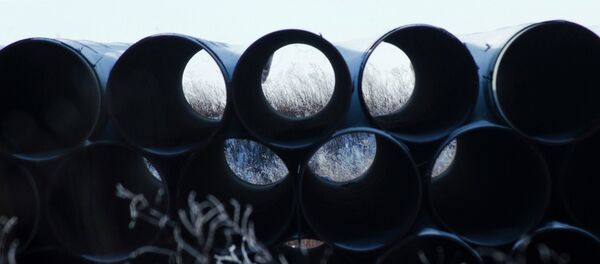MOSCOW, December 26 (Sputnik) — The year 2014 was full of notable events shaping world energy supply logistics, energy resource pricing and the shale and liquefied natural gas (LNG) industries.
Among the more notable ongoing global energy trends are oil price drops to five-year lows, pressure on the shale oil industry to turn a profit, an abrupt shift of Russian gas supplies to Europe and Asia, and the continuing controversy over the North American Keystone Pipeline system.
Oil Prices Fall
One cause of this decline is sluggish economic growth. “The pace of global recovery has disappointed in recent years… With weaker-than-expected global growth for the first half of 2014 and increased downside risks, the projected pickup in growth may again fail to materialize or fall short of expectations,” the International Monetary Fund (IMF) said, in its October World Economic Outlook. As implied by the report, slow economic growth leads to lower energy demand.
A glut in world oil supply also contributed to lower oil prices. The United States became the world’s largest oil producer this year, surpassing Saudi Arabia due to a so-called Shale Revolution.
Another blow to oil prices was delivered by the Organization of Petroleum Exporting Countries (OPEC), which decided in November to not reduce oil production amid slowing demand and rising supplies around the globe.
From squeezing revenue in oil exporting countries, such as Russia and Venezuela, to limiting the profit of the shale industry in the United States, the consequences of the drop in oil prices can have wide-ranging effect, acting beyond mere financial matters.
Russia, Gas and Three Events
All of these events took place under a backdrop of cooling relations with Western countries. Following Crimea’s reunification with Russia in March and the escalation of the military conflict in southeastern Ukraine in April, Russia was accused by its Western partners of meddling into Ukrainian internal affairs and was hit by the introduction of several rounds of sanctions, targeting the country’s banking, defense and energy spheres.
As for the energy sphere, companies from the United States and the European Union banned their companies from providing services and technology to the oil industry, Russian energy companies involved in deep-water, shale and Arctic exploration. Three major Russian companies – oil company Rosneft, oil pipeline firm Transneft and energy giant Gazprom’s oil subsidiary Gazprom Neft – were also barred from seeking finance on European capital markets.
In comparison, the only country that imports more Russian gas is Germany, with 41 billion cubic meters bought in 2013, according to Gazprom’s website. The energy giant exported a total of 220,9 billion cubic meters in 2013, so an almost 40 billion increase is indeed a significant event.
On December 9, Russia resumed gas sales to Ukraine under the deal, noting that Ukraine should repay $3.1 billion of its $5.3 billion gas debt and pay for future supplies in advance. On December 24, Gazprom confirmed it had received $1.65 billion from Ukraine as the final installment of its debt repayments.
Last, but not least, was the cancellation of the South Stream gas pipeline construction. On December 1, Russian President Vladimir Putin stated that his country “is unable to continue realization of this [South Stream] project in such conditions.”
However, Brussels repeatedly said that the project violated the European Union’s Third Energy Package, stipulating that owning a pipeline and producing the natural gas that flows through it at the same time by one entity is illegal.
Nevertheless, on the same day, December 1, Gazprom CEO Alexei Miller announced the construction of a new pipeline to Turkey with an annual capacity of 63 billion cubic meters, with 14 billion cubic meters of gas to be supplied to Turkey, and the rest — to be pumped to a hub on the Turkish-Greece border for southern Europe’s customers.
In just one year, 2014, these three events combined have changed the landscape of Russian, European and Chinese gas supply in the Eastern Hemisphere.
Stagnating Shale Industry
“I expect that the US shale revolution will shrink back greatly, perhaps continuing with existing wells, but adding many fewer wells in the future," Gail Tverberg, a fellow of the Casualty Actuarial Society told Sputnik News Agency, earlier in December.
Some experts suggest OPEC member countries, particularly Saudi Arabia, are leaving their oil production unchanged for a purpose. Willing to suffer short-term revenue shortages in order to squeeze the US shale industry out of the ‘big game’, they may hope to also deliver an economic blow to the economies of other oil-exporting countries.
Keystone XL Debate
One of the major ongoing debates in energy-hungry North America involves the XL extension of the Keystone Pipeline system. The controversial five phase Keystone oil pipeline project, initiated by Canadian energy company TransCanada Corporation in 2008 is strongly opposed by environmentalists and landowners.
Two more extensions were added in two more phases so that the pipeline could reach Texas. The Cushing Marketlink Project to Nederland, Texas, was completed in January 2014. The Houston Lateral Project, to Houston, is expected to be completed in 2015.
The final phase of the five phase project, the Keystone XL, an almost 1,200 mile cutoff between Hardisty, Alberta, and Steele City, Nebraska, awaits a judgment by US President Barack Obama. Originally proposed in 2008, 2015 will be the seventh year of intense debate and anticipation by opponents and detractors alike.
“I want to make sure that if in fact this project [Keystone Pipeline XL] goes forward, that it is not adding to the problem of climate change," President Obama said, during his annual press conference in December.
In his annual press conference, Obama defended environmental concerns, suggesting that the Keystone XL pipeline could impose “very serious costs on the American people."
TransCanada offers that, during the one or two years it will take to construct the pipeline, the XL project could “put 9,000 hard-working American men and women directly to work” and “contribute more than $3 billion towards US GDP.”










